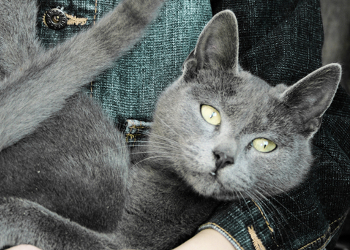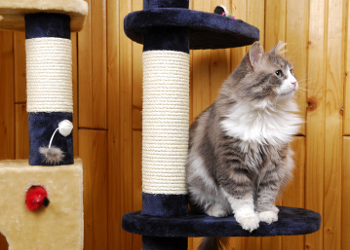Diseases #17

Canine Hip Dysplaia is a genetic disorder associated with a defect in the formation of the hip joint. It is most commonly seen in German Shepherd dogs plus other large breeds of animals. Any dog can develop the condition but the majority are large animals.
In dogs affected with Canine Hip Dysplasia the angle of the femur and the pelvis is not correct. This malformation leads to an erosion of the femoral head and poor fit into the hip socket (acetabulum). This poor mechanical situation leads to inflammation and degregation of the hip joint in question. This degregation leads to the associated clinical signs of the disease. Hip Dysplasia is always exacerbated if the animal in question is obese. Excessive weight puts a tremendous amount of stress on ANY joint; let alone the dysplastic hip.
The presentation of clinical signs varies. Some animals may not show signs for years yet others will show signs at a young age of one or two. The most common clinical signs are: lameness in the affected limb, reluctance to walk or climb stairs, pain and difficulty getting up from a sleeping position. Many animals will walk shifting their weight from the bad hip to the normal one. In time, even that hip can get sore due to the extra weight that it is supporting.
All animals in this condition should have a CBC and Chemistry Profile performed to rule out other physical causes that may make an animal APPEAR to have hip issues but is not, due to the presence of referred pain. Radiographs are always performed to determine the severity of the dyplasia as well as looking for any lytic bone activity associated with bone cancers around the femoral area (osteosarcoma). Radiographs may also be analyzed by the Orthopedic Foundation for Animals (OFA).
Diagnosis of Hip Dysplasia is made by the history, breed presentation and clinical signs. Radiographs often confirm the diagnosis once other rule outs are made.
There is no cure for canine hip dysplasia. Current therapy can be: medical, surgical plus supportive care at home. Many animals are in acute pain so anti-inflammatories are prescribed such as Rimadyl®. In severe cases, animals may be given an appropriate dose of a corticosteroid for acute relief of signs. Either of these drugs will reduce inflammation and indirectly a lot of the associated pain. Some animals may require short term use of pain killers such as Tramadol®.
In animals that are obese, a weight loss program has to be instituted. Older dogs that are overweight may also be hypothyroid. In addition to a weight loss regimen, T4 and FT4 should be performed to rule out the thyroid issue.
Animals receive a tremendous boost and benefit from neutraceuticals that stimulate production of joint cartilage. One of the more popular versions is Dasuquin®. The loading period for this nutritional supplement is about 3 weeks. That is when most dogs start to show an improvement. By employing neutraceuticals, the veterinarian is often able to reduce or eliminate the dependence on anti-inflammatory drugs that almost always have an influence on liver function. All animals that are to be placed on Rimadyl® should always have their liver enzymes checked every 6 months while on the drug.
Some owners may elect a complete hip replacement. This is performed by a board certified orthopedic surgeon. The first procedure performed on a dog (and before humans) was done at The Ohio State University College of Veterinary Medicine.
Supportive care at home is important. Owners should do as much as possible about slippery tile or wood floors. Make sure the animals bedding is thick and comfortable. Employ a gate to keep animals from falling down stairs. Clinical signs of hip dysplasia are also exacerbated in climates that have wet, cold and damp weather. Move to Florida!
The prognosis for early detected Hip Dysplasia is very good particularly if an obese animal loses weight. As long as the thigh musculature stays firm and toned via mild exercise, the majority of animals can live a normal life. Animals that are weakened in severe, advanced cases are unable to stand up. These animals have a poor prognosis.

Hookworms are intestinal parasites that can cause anemia in pets. The hookworm is caused by Ancylostoma caninum.
Hookworms are small, thin, thread like parasites that are blood suckers. If you look at the parasite under a high powered microscope, the presence of 3 pairs of sharp teeth are visible in the head region. These head parts attach to the animals small intestinal tract and suck blood.
Hookworms are transmitted from dog to dog by the oral fecal route. Contaminated feces or water are ingested. The small larva is released from its egg. The larva grows as it is attached to the intestinal tract. Males and females mate and the life cycle starts all over again. The parasite can be transmitted from a pregnant mother to her unborn puppies or kittens. They can be further parasitized by ingesting the eggs while crawling over the mother during lactation or actual skin penetration by the larvae itself. Hookworm infections are most common in areas where dogs and cats are crowded together.
Young animals are more severely effected by hookworms. They are often found together with roundworms, coccidia or Giardia. Dogs and cats will have a dry, poor hair-coat. They will often be lethargic and small for their size. In severe cases pale gums and conjunctiva are present due to the anemia caused by the parasite. Hookworms have been known to cause fatalities in small animals.
A fecal flotation is done and the characteristic eggs, and varying larval development, will be seen on a microscope slide. They are too small to be visibly seen.
Diagnosis is made by the physical condition of the patients and confirmed by finding the eggs on a microscope slide.
Treatment of hookworms is by using pyrantel paste at two week intervals for 2-3 treatments. If other parasites are present, Panacur® powder is mixed in the food daily for 3 days. Either way, a repeat stool sample has to be examined to make sure the parasite is gone. If not, the pet gets retreated again. Animals that are anemic should be put on Pet-Tinic®, a liquid meaty flavored iron supplement.
The prognosis for hookworms infections are usually excellent. The key is prevention. Feces should be picked up in the yard as soon as possible to prevent infections or repeat infections. Females that are used for breeding should have a fecal exam done before the animal is bred. If parasitized, they should be treated so they do not transmit the parasite to their unborn or new born animals. Many beaches in this country do not allow pets for a good reason. Animals can pass hookworm eggs in their feces, the eggs hatch into larva and the larvae can penetrate the skin of humans. This is called cutaneous larval migrans. When puppies are two weeks of age, a stool sample from the mother and one of her pups or kittens should be examined for intestinal parasites.

Horner's Syndrome is commonly seen in cats, not so much in dogs. It is characterized by damage to the sympathetic branch of the autonomic system. Clinical signs associated with this disease are seen in the eyes. Trauma to the nerve is one of the most common causes of Horner's Syndrome. Car accidents are a leading cause of the problem.
The autonomic nervous system is responsible for functions that we have no control over or even think about. This includes: vision, hearing, the beating of our hearts and many more. It is most understood in the fight or flight mechanism which is hard wired into all mammalian life. The autonomic system is broken down into sympathetic and parasympathetic branches. In disease treatments, many pharmacological agents will stimulate or block one or the other systems to effect clinical signs. Damage to the sympathetic system seen in the eye is caused by damage to the nerve in the ear, eye or neck area.
Drooping of the eyelid, constriction of the pupil (miosis), sunken eye and protrusion of the third eyelid are signs almost always associated with Horner's Syndrome.
Lab work entails a complete physical, eye exam, neurologic exam plus radiographs of the head and chest areas. History of prior trauma is crucial no matter how small it might be perceived to be.
Diagnosis is made by the presence of trauma and clinical signs in the animal. Other diseases cause similar signs and must be ruled out. They include facial nerve paralysis and facial muscle paralysis.
The majority of Horner's Syndrome patients will stabilize and return to normal on their own. Due to the sympathetic nerve involvement, the animal may not be able to blink its eye. Tear supplements are prescribed to lubricate the cornea to minimize the development of corneal ulcers or kerititis sicca (dry eye). Phenylephrine (stimulates the sympathetic branch) is often used to dilate the pupil.
The prognosis for Horner's Syndrome depends on the cause and severity of the lesions produced. Lesions due to trauma often respond quicker than those seen in other cases.

Hydrometra is the accumulation of a clear, serous fluid in the uterine horns in dogs and cats. It is caused by cystic hyperplasia of the uterine lining.
There is normal fluid production in the uterus during estrous (when the animal is in heat). There is an outflow or drainage problem associated with this gynecological issue. Like a sink that is stopped up, fluid will accumulate in the uterine horns. I have had one case in my career.
There may be a clear, serous vaginal discharge a month or so after estrous. If the discharge is mucoid, this condition is known as mucometra. The discharge will not be purulent or contain pus cells (like pyometra). Sometimes there are no clinical sign and the veterinarian will trip over the condition when an animal is presented to be spayed.
If a vaginal discharge is present, staining it will show no cellular debris. If the abdomen is distended, a radiograph or ultrasound is performed to check for pregnancy or some fluid contained in the uterus. A CBC and Chemistry profile are performed to rule out pyometra.
The presentation of a unaltered female several months after estrous with a clear vaginal discharge and or enlarged uterine horns can lead to a tentative diagnosis of hydrometra. Differentiation from pyometra is made by lacking a pus containing vaginal discharge containing neutrophils and lack of clinical signs of lethargy and excess fluid intake. Pyometra dogs will have a left shift neutrophilic leukocytosis while hydrometra dogs will not.
Treatment for hydrometra is spaying the animal in question. The procedure is curative and will prevent other female gynecological problems from happening in the future.
The prognosis for hydrometra cases is excellent. Once spayed, animals live a normal life. Animals can apparently live with the condition; as the middle aged dog I spayed years ago had the condition for an unknown period of time prior to surgery.

The parathyroid glands are located on or near the thyroid glands in the neck area near the larynx (voice box). The cause of this condition has not been documented in animals but could have a neoplastic, genetic, drug induced or auto-immune component
The parathyroid glands regulate blood levels of calcium and phosphorus. When levels get low, parathyroid hormone is stimulated and bone calcium is absorbed into the general circulation. With insufficient production of the hormone, blood calcium levels decrease. This is called hypocalcemia and can lead to severe neurological signs such as seizures and tremors. Insufficient hormone production can also occur if the thyroid glands are removed; taking the parathyroid glands with it.
Signs associated with hypoparathyroidism are neurological in nature. Animals may act disoriented, weak, stumble, seizure, have a fever, twitch and walk stiff as if suffering from arthritis.
A CBC and Chemistry profile are performed. It will show low serum calcium levels and high serum phosphate levels. A PTH assay test to actually measure the level of parathyroid hormone present is diagnostic.
A history and associated clinical signs plus lab work will aid in the diagnosis of hypoparathyroidism. Many dogs are staggering or in full blown seizures. These need to be differentiated from other diseases such as: true idiopathic or toxin related seizures, hypoglycemia caused by a pancreatic insuloma, hypoglycemia seen in diabetics given too much insulin and other causes.
Once the condition is diagnosed, the immediate goal is to raise the serum calcium levels back to a more normal level and stop seizure activity. The former is accomplished by intravenous injections of calcium gluconate. The latter, by intravenous doses of diazepam. Animals are hospitalized and stabilized with other necessary supportive care. Once the animal is stabilized, vitamin D and oral calcium are provided. Vitamin D has a sole function of facilitating the absorption of calcium from the gut. Animals have to be hospitalized initially for this since it takes about 3-4 days for oral calcium supplements to take effect. In the mean time animals will need parenteral administration of calcium gluconate. Once discharged, blood work and repeat physical exams are necessary.
The prognosis for parathyroid hormone deficient animals is very good as long as it is diagnosed and treated early, as well as maintained on adequate replacement therapy.

